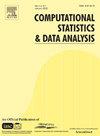Analysis of order-of-addition experiments
IF 1.5
3区 数学
Q3 COMPUTER SCIENCE, INTERDISCIPLINARY APPLICATIONS
引用次数: 0
Abstract
The order-of-addition (OofA) experiment involves arranging components in a specific order to optimize a certain objective, which is attracting a great deal of attention in many disciplines, especially in the areas of biochemistry, scheduling, and engineering. Recent studies have highlighted its significance, and notable works have aimed to address NP-hard OofA problems from a statistical perspective. However, solving OofA problems presents challenges due to their complex nature and the presence of uncertainty, such as scheduling problems with uncertain processing times. These uncertainties affect processing times, which are not known with certainty in advance. They introduce heteroscedasticity into OofA experiments, where different orders result in varying dispersions. To address these challenges, a unified framework is proposed to analyze scheduling problems without making specific assumptions about the distribution of these certainties. It encompasses model development and optimization, encapsulating existing homoscedastic studies (where different orders produce the same dispersion value) as a specific instance. For heteroscedastic cases, a dual response optimization within an uncertainty set is proposed, aiming to minimize the dispersion of response while keeping the location of response with a predefined target value. However, solving the proposed non-linear minimax optimization is rather challenging. An equivalent optimization formulation with low computational cost is proposed for solving such a challenging problem. Theoretical supports are established to ensure the tractability of the proposed method. Simulation studies are conducted to demonstrate the effectiveness of the proposed approach. With its solid theoretical support, ease of implementation, and ability to find an optimal order, the proposed approach offers a practical and competitive solution to solving general order-of-addition problems.
阶次添加实验分析
加序(OofA)实验涉及按特定顺序排列组件以优化某个目标,在许多学科,尤其是生物化学、调度和工程学领域引起了广泛关注。最近的研究凸显了它的重要性,一些著名的著作旨在从统计学的角度来解决 NP 难的 OofA 问题。然而,由于 OofA 问题的复杂性和不确定性(如处理时间不确定的调度问题)的存在,解决 OofA 问题面临着挑战。这些不确定性会影响处理时间,而处理时间是无法事先确定的。它们在 OofA 实验中引入了异方差性,不同的订单会导致不同的分散性。为了应对这些挑战,我们提出了一个统一的框架来分析调度问题,而无需对这些不确定性的分布做出具体假设。该框架包括模型开发和优化,将现有的同散性研究(不同订单产生相同的离散值)封装为一个具体实例。对于异方差情况,提出了不确定性集内的双重响应优化,旨在最小化响应的离散性,同时将响应位置保持在预定义的目标值上。然而,求解所提出的非线性最小值优化相当具有挑战性。为解决这一难题,我们提出了一种计算成本较低的等效优化公式。建立了理论支持,以确保所提方法的可操作性。仿真研究证明了所提方法的有效性。凭借其坚实的理论支持、易于实施和找到最优阶次的能力,所提出的方法为解决一般加阶问题提供了一种实用且有竞争力的解决方案。
本文章由计算机程序翻译,如有差异,请以英文原文为准。
求助全文
约1分钟内获得全文
求助全文
来源期刊

Computational Statistics & Data Analysis
数学-计算机:跨学科应用
CiteScore
3.70
自引率
5.60%
发文量
167
审稿时长
60 days
期刊介绍:
Computational Statistics and Data Analysis (CSDA), an Official Publication of the network Computational and Methodological Statistics (CMStatistics) and of the International Association for Statistical Computing (IASC), is an international journal dedicated to the dissemination of methodological research and applications in the areas of computational statistics and data analysis. The journal consists of four refereed sections which are divided into the following subject areas:
I) Computational Statistics - Manuscripts dealing with: 1) the explicit impact of computers on statistical methodology (e.g., Bayesian computing, bioinformatics,computer graphics, computer intensive inferential methods, data exploration, data mining, expert systems, heuristics, knowledge based systems, machine learning, neural networks, numerical and optimization methods, parallel computing, statistical databases, statistical systems), and 2) the development, evaluation and validation of statistical software and algorithms. Software and algorithms can be submitted with manuscripts and will be stored together with the online article.
II) Statistical Methodology for Data Analysis - Manuscripts dealing with novel and original data analytical strategies and methodologies applied in biostatistics (design and analytic methods for clinical trials, epidemiological studies, statistical genetics, or genetic/environmental interactions), chemometrics, classification, data exploration, density estimation, design of experiments, environmetrics, education, image analysis, marketing, model free data exploration, pattern recognition, psychometrics, statistical physics, image processing, robust procedures.
[...]
III) Special Applications - [...]
IV) Annals of Statistical Data Science [...]
 求助内容:
求助内容: 应助结果提醒方式:
应助结果提醒方式:


